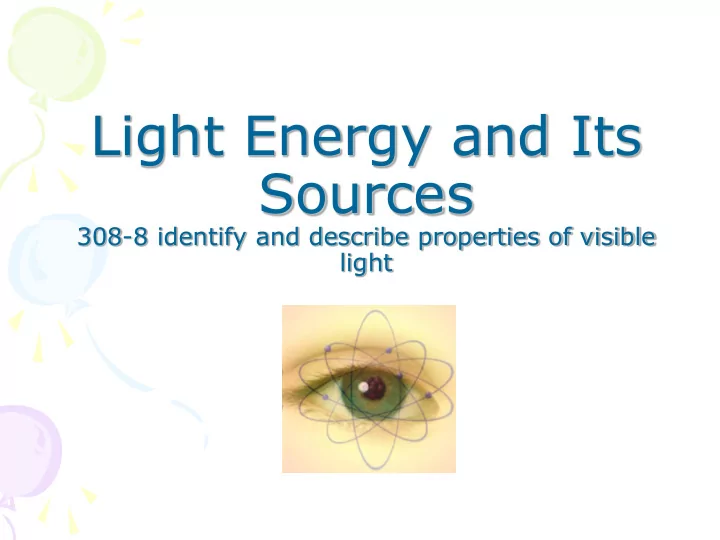

Light Energy and Its Sources 308-8 identify and describe properties of visible light
What is light? Light is a form of energy that can be detected by the human eye. Light cannot be touched or tasted, but it can warm things up so it gives heat energy to objects.
Energy Energy is the ability to do work. Energy can be neither created nor destroyed. Energy can only be transformed from one form to another.
Where does light energy come from? Light energy comes form two different sources, natural and artificial.
What is the most important source for natural light? The sun is the most important source for natural light.
• Objects that emit (give off) their own light are called luminous. • Objects that do not emit light, but reflect it from other sources are called nonluminous.
What are some examples of luminous objects?
Luminous objects are objects that give off their own light.
What are some examples of nonluminous objects?
Nonluminous objects are objects that do not give off light.
Why is the Moon nonluminous? The Moon is nonluminous because it reflects light from the Sun
What are some common forms of luminous energy? Chemical energy Electrical energy Nuclear energy Thermal energy
Sources of Light 1. Light from Incandescence – Incandescent source means the process of giving off light because of the high temperature. Light produced by a flame, candle, campfire, or light bulb.
2. Light from Phosphorescence – Some materials, called phosphors, give off light for a short time after you shine a light on them. They store the energy and then release it as light energy.
3. Light from Electric Discharge – An electric discharge is the process by which a gas releases light because of electricity passing through it.
4. Light from Fluorescence – The release of light from a substance caused by exposure to radiation from an external source.
Where are fluorescent lights used? Schools Offices Homes
What happens inside a fluorescent light? In fluorescent lighting, the tube glows when ultraviolet light energy strikes the phosphors lining the tube. The tube stops emitting light immediately after the electric current is turned off. Phosphorescent light sources continue to emit light for much longer period after receiving light energy.
What is a chemical reaction? When two chemicals react and a new compound is formed. When substances are mixed and new substances are formed, a chemical reaction has occurred. Change that takes place when two or more substances (reactants) interact to form new substances (products).
5. Light from Chemiluminescence – Chemiluminescene is the process of changing chemical energy into light energy with little or no change in temperature.
6. Light from Bioluminescence – some living things, such as fish, can make themselves luminous using a chemical reaction like chemiluminescence.
Give examples of bioluminescence . Firefly Glow worm Zebra Fish Hawaiian bobtail squid
Bacteria Fungi (mushrooms)
Daytime Nighttime
Properties of Light • Light travels in a straight line (rectilinear propagation) • Light travels at a speed of 300 000 km/s in air • Reflection • Refraction and dispersion • Light travels in a vacuum and in some other types of media * We will explore these properties in more detail throughout this unit.
Understanding Concepts
• Questions • Page 271 • 1, 2, 3, 4
Which of the following are luminous? A. Campfire B. The Moon C. A hot toaster filament
The campfire and hot toaster are luminous. WHY? For, luminous objects are objects that give off their own light.
Describe how a flashlight can be luminous. A flashlight becomes luminous when it is switched on, allowing the chemical energy in the battery to become electrical energy, which in turn becomes light energy (heat) in the bulb.
Describe how it can also be nonluminous . The flashlight can be nonluminous when it is turned off.
Investigation • On your own, you are going to investigate “fuzzy” and “sharp” shadows. • What are they? Show some examples (draw or print pictures 2 pictures for each) • What causes one to be sharp and the other to be fuzzy? • I am just looking for a little write-up about each to be passed in for evaluation.
Light Box • You are going to make a light box to see how light travels in a straight line. • See instruction sheet.
Recommend
More recommend